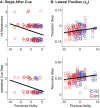This is a preprint.
How Healthy Older Adults Enact Lateral Maneuvers While Walking
- PMID: 36909583
- PMCID: PMC10002645
- DOI: 10.1101/2023.02.24.529927
How Healthy Older Adults Enact Lateral Maneuvers While Walking
Update in
-
How Healthy Older Adults Enact Lateral Maneuvers While Walking.Gait Posture. 2024 Feb;108:117-123. doi: 10.1016/j.gaitpost.2023.11.020. Epub 2023 Nov 24. Gait Posture. 2024. PMID: 38035512 Free PMC article.
Abstract
Background: Walking requires frequent maneuvers to navigate changing environments with shifting goals. Humans accomplish maneuvers and simultaneously maintain balance primarily by modulating their foot placement, but a direct trade-off between these two objectives has been proposed. As older adults rely more on foot placement to maintain lateral balance, they may be less able to adequately adapt stepping to perform lateral maneuvers.
Research question: How do older adults adapt stepping to enact lateral lane-change maneuvers, and how do physical and perceived ability influence their task performance?
Methods: Twenty young (21.7 ± 2.6 yrs) and 18 older (71.6 ± 6.0 yrs) adults walked on a motorized treadmill in a virtual environment. Following an audible and visual cue, participants switched between two parallel paths, centered 0.6m apart, to continue walking on their new path. We quantified when participants initiated the maneuver following the cue, as well as their step width, lateral position, and stepping variability ellipses at each maneuver step.
Results: Young and older adults did not differ in when they initiated the maneuver, but participants with lower perceived ability took longer to do so. Young and older adults also did not exhibit differences in step width or lateral positions at any maneuver step, but participants with greater physical ability reached their new path faster. While only older adults exhibited stepping adaptations prior to initiating the maneuver, both groups traded-off stability for maneuverability to enact the lateral maneuver.
Significance: Physical and perceived balance ability, rather than age per se, differentially influenced maneuver task performance. Humans must make decisions related to the task of walking itself and do so based on both physical and perceived factors. Understanding and targeting these interactions may help improve walking performance among older adults.
Keywords: Aging; Balance; Lateral Maneuvers; Perception; Walking.
Conflict of interest statement
Conflict of Interest Statement The authors declare that there are no conflicts of interest associated with this work.
Figures




References
-
- Kuo A.D., Stabilization of lateral motion in passive dynamic walking, Int. J. Robotics Res. 18(9) (1999) 917–930. 10.1177/02783649922066655 - DOI
Publication types
Grants and funding
LinkOut - more resources
Full Text Sources
Research Materials
